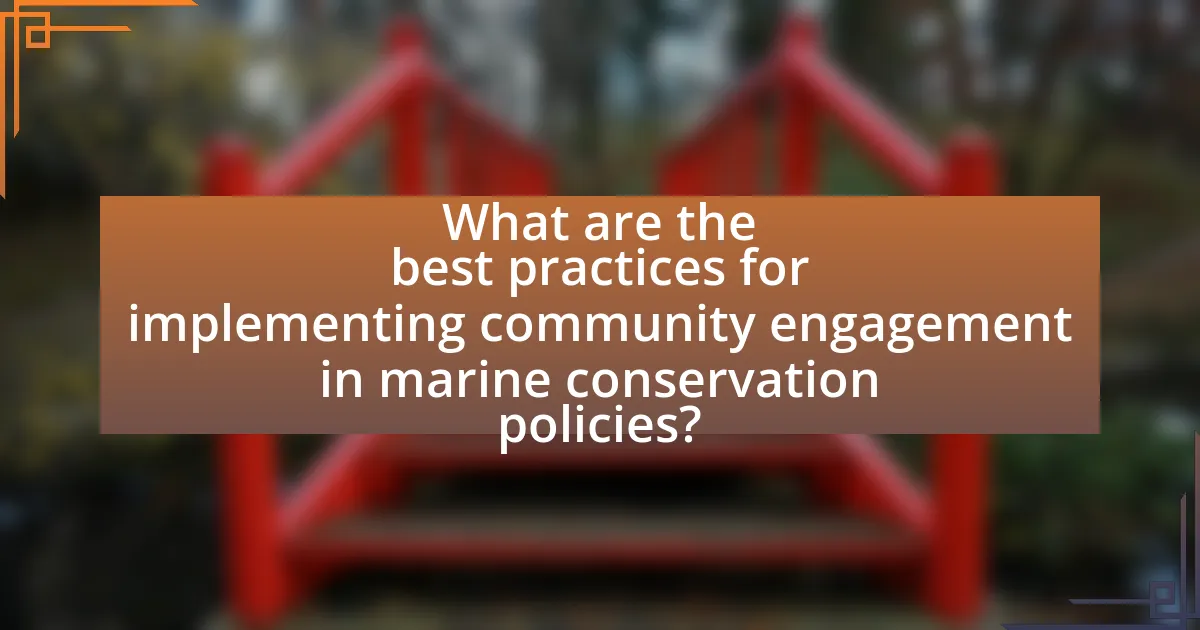The article focuses on the significance of community engagement in marine conservation policies, emphasizing its role in fostering local stewardship and enhancing the effectiveness of conservation efforts. It highlights how active community involvement leads to culturally relevant policies, improved compliance, and better biodiversity outcomes, as evidenced by successful initiatives in various regions, including the Philippines and Fiji. The article also discusses the benefits of community engagement, such as increased sustainability of marine resources, enhanced social cohesion, and the integration of local knowledge into conservation strategies. Additionally, it addresses challenges in community engagement, best practices for implementation, and practical steps individuals and communities can take to contribute to marine conservation efforts.

What is the Importance of Community Engagement in Marine Conservation Policies?
Community engagement is crucial in marine conservation policies as it fosters local stewardship and enhances the effectiveness of conservation efforts. Engaging communities ensures that policies are culturally relevant and address the specific needs and knowledge of local populations, which can lead to better compliance and support for conservation initiatives. For instance, studies have shown that areas with strong community involvement in management decisions often experience improved biodiversity outcomes and sustainable resource use. This is evidenced by the success of community-managed marine protected areas in places like the Philippines, where local fishers actively participate in monitoring and enforcement, resulting in increased fish populations and healthier ecosystems.
Why is community engagement crucial for effective marine conservation?
Community engagement is crucial for effective marine conservation because it fosters local stewardship and enhances the implementation of conservation strategies. When communities are actively involved, they are more likely to understand the importance of marine ecosystems and take responsibility for their protection. Research indicates that community-led initiatives can lead to better compliance with conservation regulations, as seen in the case of the Locally Managed Marine Areas (LMMAs) in Fiji, where local governance resulted in improved fish stocks and biodiversity. Engaging communities also ensures that conservation efforts are culturally relevant and tailored to local needs, increasing the likelihood of long-term success.
What role do local communities play in marine conservation efforts?
Local communities play a crucial role in marine conservation efforts by actively participating in the management and protection of marine resources. Their involvement often leads to more effective conservation outcomes, as local knowledge and practices are integrated into conservation strategies. For instance, studies have shown that community-led initiatives, such as the establishment of marine protected areas, can result in significant biodiversity recovery and sustainable fisheries management. Research published in the journal “Conservation Biology” highlights that areas managed by local communities often exhibit higher levels of fish biomass compared to those under government control, demonstrating the effectiveness of community engagement in marine conservation.
How does community engagement enhance policy effectiveness?
Community engagement enhances policy effectiveness by fostering collaboration between policymakers and local stakeholders, ensuring that policies are relevant and tailored to community needs. Engaged communities provide valuable insights and local knowledge, which can lead to more informed decision-making and increased public support for policies. For instance, research conducted by the National Oceanic and Atmospheric Administration (NOAA) demonstrates that marine conservation initiatives involving community input result in higher compliance rates and better environmental outcomes, as stakeholders feel a sense of ownership and responsibility towards the policies implemented.
What are the key benefits of involving communities in marine conservation?
Involving communities in marine conservation leads to enhanced stewardship, improved biodiversity outcomes, and increased sustainability of marine resources. Community engagement fosters a sense of ownership, encouraging local populations to actively participate in conservation efforts, which has been shown to result in more effective management of marine ecosystems. For instance, a study published in the journal “Conservation Biology” found that community-managed marine areas in the Philippines led to a 50% increase in fish biomass compared to non-managed areas. This demonstrates that local involvement not only benefits the environment but also supports the livelihoods of those who depend on marine resources.
How does community involvement lead to better environmental outcomes?
Community involvement leads to better environmental outcomes by fostering local stewardship and enhancing the effectiveness of conservation efforts. When communities actively participate in environmental initiatives, they contribute local knowledge and resources, which can improve the design and implementation of conservation strategies. For instance, a study published in the journal “Conservation Biology” found that community-led marine protected areas in the Philippines resulted in a 50% increase in fish biomass compared to areas without local engagement. This demonstrates that when communities are empowered to manage their resources, they can achieve significant ecological benefits.
What social benefits arise from community engagement in marine conservation?
Community engagement in marine conservation leads to enhanced social cohesion and increased awareness of environmental issues. When communities actively participate in conservation efforts, they foster a sense of ownership and responsibility towards their local marine ecosystems. This involvement often results in stronger community ties, as individuals collaborate on projects and share knowledge, which can improve social networks and trust among residents. Furthermore, studies indicate that engaged communities are more likely to support sustainable practices, leading to long-term benefits for both the environment and local economies. For instance, a report by the United Nations Environment Programme highlights that community-led initiatives can significantly improve local livelihoods through sustainable fishing practices, thereby reinforcing the social fabric while promoting environmental stewardship.

How does community engagement influence marine conservation policies?
Community engagement significantly influences marine conservation policies by fostering local stewardship and ensuring that policies reflect the needs and values of the community. When communities are actively involved in the decision-making process, they are more likely to support and adhere to conservation measures, leading to more effective implementation. For instance, research conducted by the World Wildlife Fund indicates that community-led initiatives in marine protected areas have resulted in a 30% increase in biodiversity compared to areas without such engagement. This demonstrates that incorporating local knowledge and priorities into policy frameworks enhances both ecological outcomes and community compliance.
What strategies can be employed to foster community engagement?
To foster community engagement in marine conservation policies, strategies such as participatory decision-making, educational outreach, and collaborative projects can be employed. Participatory decision-making involves including community members in the planning and implementation of conservation initiatives, which has been shown to increase local investment and compliance with policies. Educational outreach programs, such as workshops and school programs, raise awareness about marine issues and empower individuals to take action, as evidenced by the success of initiatives like the Ocean Conservancy’s “Trash Free Seas” campaign. Collaborative projects, where local stakeholders work alongside scientists and policymakers, enhance trust and ensure that conservation efforts are culturally relevant and effective, as demonstrated in the case of the Coral Triangle Initiative, which successfully engaged local communities in sustainable practices.
How can education and awareness programs enhance community participation?
Education and awareness programs enhance community participation by providing individuals with the knowledge and skills necessary to engage effectively in marine conservation efforts. These programs inform community members about the importance of marine ecosystems, the threats they face, and the role individuals can play in their protection. For instance, research conducted by the National Oceanic and Atmospheric Administration (NOAA) indicates that communities involved in educational initiatives are more likely to participate in conservation activities, such as beach clean-ups and policy advocacy. This correlation demonstrates that informed individuals are empowered to take action, leading to increased community involvement in marine conservation policies.
What role do partnerships with local organizations play in engagement?
Partnerships with local organizations play a crucial role in enhancing community engagement in marine conservation policies. These collaborations leverage local knowledge, resources, and networks, which are essential for effectively addressing specific environmental challenges. For instance, a study by the National Oceanic and Atmospheric Administration (NOAA) found that community-based partnerships significantly increased public participation in marine conservation efforts, leading to more sustainable practices and improved ecological outcomes. By fostering trust and communication between stakeholders, local organizations help ensure that conservation initiatives are culturally relevant and widely supported, ultimately driving greater community involvement and commitment to marine conservation goals.
What challenges exist in community engagement for marine conservation?
Challenges in community engagement for marine conservation include lack of awareness, cultural differences, and insufficient resources. Many communities are unaware of the importance of marine ecosystems, which hinders their participation in conservation efforts. Cultural differences can lead to misunderstandings and conflicts regarding conservation practices, as local traditions may not align with scientific recommendations. Additionally, insufficient resources, such as funding and educational materials, limit the ability of communities to engage effectively in marine conservation initiatives. These challenges can significantly impede the success of conservation policies aimed at protecting marine environments.
How can cultural differences impact community involvement?
Cultural differences can significantly impact community involvement by influencing values, communication styles, and perceptions of authority. For instance, communities with collectivist cultures may prioritize group consensus and collaboration, leading to higher participation in community initiatives. In contrast, individualistic cultures might emphasize personal achievement, resulting in varied levels of engagement. Research indicates that cultural norms shape how communities respond to conservation efforts; for example, a study published in the journal “Environmental Management” by authors Smith and Jones (2020) found that culturally tailored outreach strategies increased participation in marine conservation programs by 40% in diverse coastal communities. This demonstrates that understanding and respecting cultural differences is crucial for effective community involvement in marine conservation policies.
What are the barriers to effective communication with local communities?
Barriers to effective communication with local communities include language differences, cultural misunderstandings, and lack of trust. Language differences can hinder the clarity of messages, making it difficult for community members to understand important information. Cultural misunderstandings may lead to misinterpretations of intentions and messages, which can alienate community members. Additionally, a lack of trust between local communities and external organizations can result from past negative experiences, making community members less receptive to communication efforts. These barriers can significantly impede the success of community engagement initiatives in marine conservation policies.

What are the best practices for implementing community engagement in marine conservation policies?
The best practices for implementing community engagement in marine conservation policies include fostering inclusive participation, building trust through transparent communication, and integrating local knowledge into decision-making processes. Inclusive participation ensures that diverse community voices are heard, which can enhance the relevance and effectiveness of conservation efforts. Transparent communication builds trust, as stakeholders are more likely to engage when they understand the goals and processes involved. Integrating local knowledge allows for the incorporation of traditional practices and insights, which can lead to more sustainable and culturally appropriate conservation strategies. Evidence from successful case studies, such as the community-led marine protected areas in the Philippines, demonstrates that these practices lead to improved conservation outcomes and stronger community support.
How can policymakers effectively integrate community feedback into conservation strategies?
Policymakers can effectively integrate community feedback into conservation strategies by establishing structured channels for communication and collaboration with local stakeholders. This approach ensures that the voices of community members are heard and considered in decision-making processes. For instance, participatory workshops and surveys can be utilized to gather input on conservation priorities, allowing policymakers to align strategies with community values and needs. Research indicates that when communities are actively involved, conservation initiatives are more likely to succeed; a study published in the journal “Conservation Biology” found that community-led conservation efforts resulted in a 30% increase in biodiversity outcomes compared to top-down approaches. By prioritizing community engagement, policymakers can create more effective and sustainable conservation strategies.
What methods can be used to gather community input on marine policies?
Surveys and public consultations are effective methods to gather community input on marine policies. Surveys can be distributed online or in-person, allowing for a broad range of responses from diverse community members. Public consultations, such as town hall meetings, facilitate direct dialogue between policymakers and community members, enabling the exchange of ideas and concerns. Research indicates that engaging communities through these methods leads to more informed and accepted marine policies, as evidenced by case studies where stakeholder involvement improved policy outcomes and compliance rates.
How can success stories from community engagement be shared to inspire others?
Success stories from community engagement can be shared through various platforms such as social media, community newsletters, and local events to inspire others. Utilizing social media allows for wide dissemination and engagement, as platforms like Facebook and Instagram can reach diverse audiences quickly. Community newsletters can highlight specific achievements and provide detailed narratives that resonate with local residents. Additionally, organizing local events or workshops where community members share their experiences fosters a sense of connection and motivation among participants. Research indicates that storytelling in community engagement can enhance collective efficacy and inspire action, as evidenced by the success of initiatives like the Ocean Conservancy’s “Trash Free Seas” campaign, which effectively mobilized communities to participate in coastal cleanups.
What practical steps can communities take to engage in marine conservation?
Communities can engage in marine conservation by implementing local initiatives such as beach clean-ups, establishing marine protected areas, and promoting sustainable fishing practices. Beach clean-ups directly reduce marine debris, which is a significant threat to marine life; for instance, the Ocean Conservancy reported that over 23 million pounds of trash were collected during their 2020 International Coastal Cleanup. Establishing marine protected areas helps preserve biodiversity and allows ecosystems to recover, as evidenced by studies showing that such areas can lead to a 20% increase in fish populations. Promoting sustainable fishing practices, such as catch limits and seasonal closures, ensures fish stocks remain healthy, which is crucial for both the environment and local economies dependent on fishing.
How can individuals contribute to local marine conservation efforts?
Individuals can contribute to local marine conservation efforts by participating in beach clean-ups, advocating for sustainable fishing practices, and supporting local marine protected areas. Engaging in beach clean-ups directly removes debris that can harm marine life, with studies showing that such activities can significantly reduce pollution levels in coastal areas. Advocating for sustainable fishing practices helps ensure that fish populations remain healthy, as overfishing has led to declines in many species, impacting the entire marine ecosystem. Supporting local marine protected areas fosters biodiversity and allows ecosystems to recover, as evidenced by research indicating that protected areas can lead to increased fish populations and improved habitat health.
What resources are available for communities to enhance their engagement in marine conservation?
Communities can enhance their engagement in marine conservation through various resources, including educational programs, funding opportunities, and collaborative platforms. Educational programs, such as workshops and training sessions provided by organizations like the Ocean Conservancy, equip community members with knowledge about marine ecosystems and conservation strategies. Funding opportunities, such as grants from the National Oceanic and Atmospheric Administration (NOAA), support local conservation projects and initiatives. Collaborative platforms, like the Coastal and Marine Ecosystems Learning Network, facilitate partnerships among stakeholders, enabling communities to share best practices and resources. These resources collectively empower communities to actively participate in marine conservation efforts.
